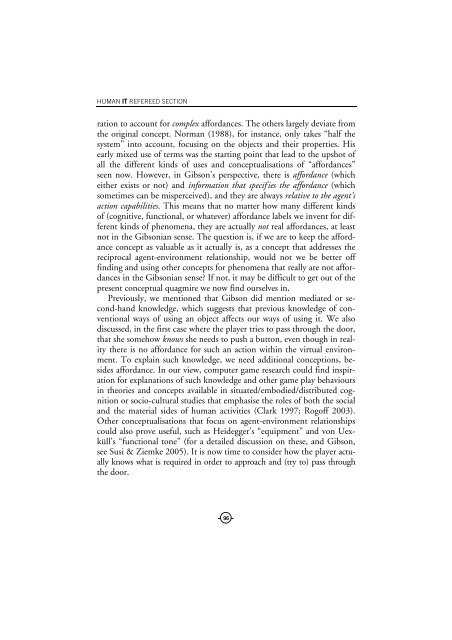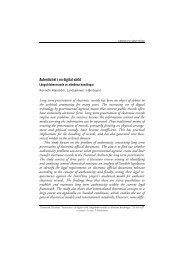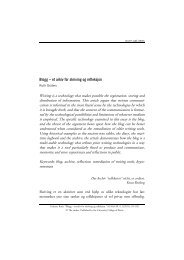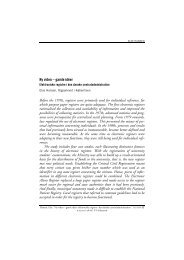The Challenge of Managing Affordances in Computer Game Play
The Challenge of Managing Affordances in Computer Game Play
The Challenge of Managing Affordances in Computer Game Play
You also want an ePaper? Increase the reach of your titles
YUMPU automatically turns print PDFs into web optimized ePapers that Google loves.
HUMAN IT REFEREED SECTION<br />
ration to account for complex affordances. <strong>The</strong> others largely deviate from<br />
the orig<strong>in</strong>al concept. Norman (1988), for <strong>in</strong>stance, only takes “half the<br />
system” <strong>in</strong>to account, focus<strong>in</strong>g on the objects and their properties. His<br />
early mixed use <strong>of</strong> terms was the start<strong>in</strong>g po<strong>in</strong>t that lead to the upshot <strong>of</strong><br />
all the different k<strong>in</strong>ds <strong>of</strong> uses and conceptualisations <strong>of</strong> “affordances”<br />
seen now. However, <strong>in</strong> Gibson’s perspective, there is affordance (which<br />
either exists or not) and <strong>in</strong>formation that specifies the affordance (which<br />
sometimes can be misperceived), and they are always relative to the agent’s<br />
action capabilities. This means that no matter how many different k<strong>in</strong>ds<br />
<strong>of</strong> (cognitive, functional, or whatever) affordance labels we <strong>in</strong>vent for different<br />
k<strong>in</strong>ds <strong>of</strong> phenomena, they are actually not real affordances, at least<br />
not <strong>in</strong> the Gibsonian sense. <strong>The</strong> question is, if we are to keep the affordance<br />
concept as valuable as it actually is, as a concept that addresses the<br />
reciprocal agent-environment relationship, would not we be better <strong>of</strong>f<br />
f<strong>in</strong>d<strong>in</strong>g and us<strong>in</strong>g other concepts for phenomena that really are not affordances<br />
<strong>in</strong> the Gibsonian sense? If not, it may be difficult to get out <strong>of</strong> the<br />
present conceptual quagmire we now f<strong>in</strong>d ourselves <strong>in</strong>.<br />
Previously, we mentioned that Gibson did mention mediated or second-hand<br />
knowledge, which suggests that previous knowledge <strong>of</strong> conventional<br />
ways <strong>of</strong> us<strong>in</strong>g an object affects our ways <strong>of</strong> us<strong>in</strong>g it. We also<br />
discussed, <strong>in</strong> the first case where the player tries to pass through the door,<br />
that she somehow knows she needs to push a button, even though <strong>in</strong> reality<br />
there is no affordance for such an action with<strong>in</strong> the virtual environment.<br />
To expla<strong>in</strong> such knowledge, we need additional conceptions, besides<br />
affordance. In our view, computer game research could f<strong>in</strong>d <strong>in</strong>spiration<br />
for explanations <strong>of</strong> such knowledge and other game play behaviours<br />
<strong>in</strong> theories and concepts available <strong>in</strong> situated/embodied/distributed cognition<br />
or socio-cultural studies that emphasise the roles <strong>of</strong> both the social<br />
and the material sides <strong>of</strong> human activities (Clark 1997; Rog<strong>of</strong>f 2003).<br />
Other conceptualisations that focus on agent-environment relationships<br />
could also prove useful, such as Heidegger’s “equipment” and von Uexküll’s<br />
“functional tone” (for a detailed discussion on these, and Gibson,<br />
see Susi & Ziemke 2005). It is now time to consider how the player actually<br />
knows what is required <strong>in</strong> order to approach and (try to) pass through<br />
the door.<br />
96









